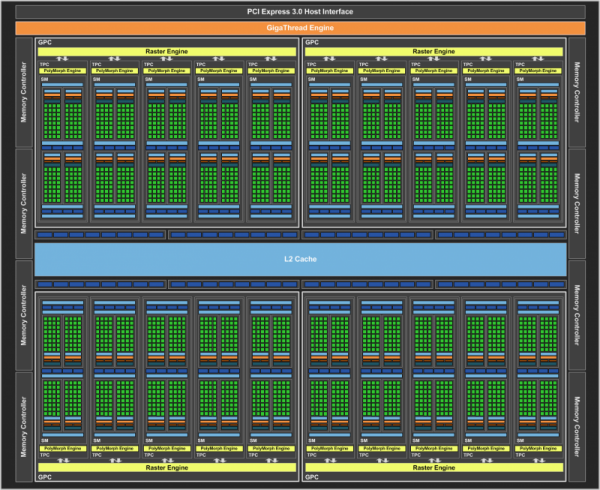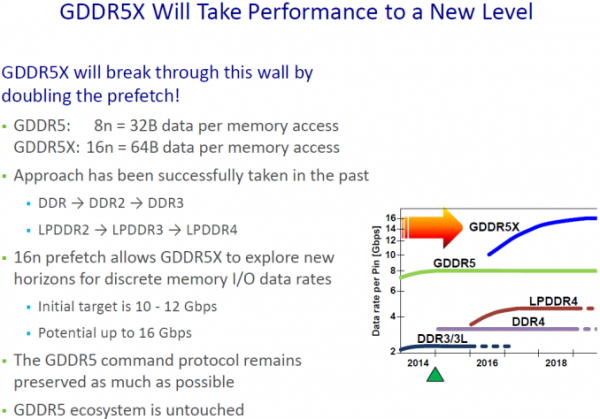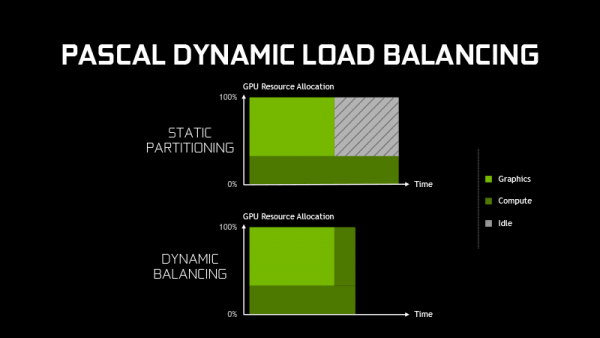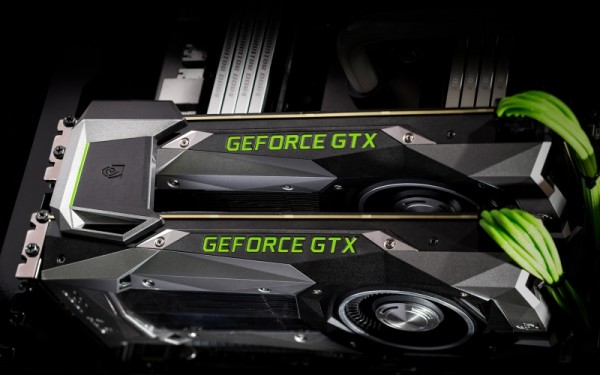GeForce GTX 1080

GeForce GTX 1080 - built on the basis of the GP104 GPU - the second oldest chip in the Pascal line. P104 compared to P100 is almost half the number of transistors and chip area. If we start from the Maxwell line, then the new chip occupies an intermediate position between the GM204, which NVIDIA uses in the GeForce GTX 970/980, and the GM200 (GeForce GTX 980 Ti and GTX 980 TITAN X) both in terms of the “physical” parameters of the crystal and the number of CUDA cores and texture modules. The GP104's back-end configuration unmistakably defines its position as a successor to the GM204, as it also comes with a 256-bit memory bus shared between eight controllers and 64 ROPs.
From the point of view of the layout of GPU computing units, the Pascal architecture in the GP104 implementation exactly follows the principles laid down in Maxwell. All computational logic is concentrated in structures called Graphics Processing Cluster (GPC) - there are four of them in this processor. Inside the GPC are five Stream Multiprocessors, each of which includes 128 CUDA cores, 8 texture modules and an L1 cache section that is increased from 24 to 48 KB compared to Maxwell. Each GPC also includes a single Polymorph Engine (Raster Engine in the diagram) that performs the initial rendering steps: polygon edge detection, projection, and culling of invisible pixels.
The main achievement of the 16 nm process here is expressed in clock frequencies that have almost doubled compared to the GeForce GTX 980: the base frequency is 1607 MHz, the Boost Clock is 1733 MHz (since the latter is the average frequency in typical applications, the GTX 1080 is able to accelerate to higher values.
Double precision calculations (FP64) are performed by the GP104 processor at a speed of 1/32 of the FP32 - in this it inherits the chips of the second and subsequent tiers of the Maxwell family. The Pascal architecture can also execute FP16 operations at twice the performance of FP32, while Maxwell executes them at the same speed. In terms of power consumption, the GeForce GTX 1080 belongs to the same class as the GeForce GTX 980 - 180 watts. Based on this data and the declared performance in TFLOPS for the GTX 980 and GTX 1080, we get a 63% increase in Pascal's energy efficiency compared to Maxwell. The amount of RAM is 8 GB of GDDR5X type - the amount that was previously the prerogative of AMD graphics cards based on Hawaii GPUs with a 512-bit memory bus.
One of the key differences between GDDR5X and GDDR5 is the ability to transmit four bits of data per signal cycle (QDR - Quad Data Rate) as opposed to two bits (DDR - Double Data Rate), as was the case in all previous modifications of DDR SDRAM memory. The physical frequencies of the memory cores and the data transfer interface are located approximately in the same range as that of the GDDR5 chips.
Specifications GeForce GTX 1080
|
|
||||||
|
Chip
|
||||||
|
Frequencies
|
||||||
|
Memory
|
||||||
|
Interface and TDP
|
And in order to saturate the increased bandwidth of the chips with data, GDDR5X uses a data prefetch increased from 8n to 16n. With a 32-bit interface of a separate chip, this means that the controller selects not 32, but 64 bytes of data in one memory access cycle. As a result, the resulting interface bandwidth reaches 10-14 Gb / s per pin at a CK (command clock) frequency of 1250-1750 MHz - this is the frequency shown by utilities for monitoring and overclocking video cards, such as GPU-Z. At least for now, such figures are included in the standard, but in the future Micron plans to reach numbers up to 16 Gb / s.
The next advantage of GDDR5X is the increased chip volume - from 8 to 16 Gbps. The GeForce GTX 1080 comes with eight 8Gb chips, but in the future, graphics card manufacturers will be able to double the amount of RAM as more capacious chips become available. Like GDDR5, GDDR5X allows the use of two chips on one 32-bit controller in the so-called clamshell mode, which makes it possible to address 32 GB of memory on a 256-bit GP104 bus.
The Maxwell architecture already has the broadest GPU support on the market for the new rendering features in DirectX 12 (feature level 12_1). Pascal adds a few more options to this arsenal that also have potential for VR applications. Async Compute - one of the DirectX 12 features, previously only found on AMD GCN processors, allows you to dynamically allocate GPU resources between graphics and computing workloads so that the resources freed up after the completion of one of the tasks can be immediately transferred to the remaining task.
While AMD switched to PCI Express synchronization in multi-GPU configurations, NVIDIA still uses a separate interface in SLI. However, the fact that at sufficiently high screen resolutions, NVIDIA GPUs also exchange part of the data via PCI Express escaped public attention. This suggests that in the form that was implemented in previous NVIDIA architectures, SLI has already exhausted its bandwidth limit. As far as we know, it is 1 GB / s, which is no longer enough to exchange frames in a resolution of 3840x2160 at 60 Hz.
But instead of completely switching to PCI Express, Pascal reworked the existing interface. Traditionally, an NVIDIA graphics card has two SLI connections that work simultaneously to link the GPU to its neighbors in a triple or quad configuration, but only one channel is used for data transfer in a dual-processor bundle. Using two channels in tandem with the GPU is the most obvious way to increase performance, and that's exactly what happened in Pascal.
NVIDIA also released a special bridge, available in several versions of various lengths, that has improved physical characteristics to allow the interface to operate at a frequency increased from the previous 400 MHz to 650 MHz.







